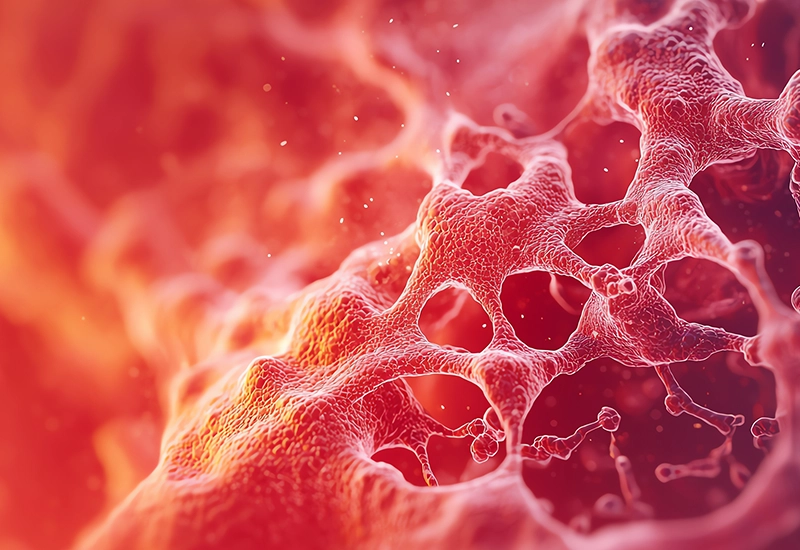The vital role of microcirculation
Microcirculation, the intricate network of the smallest blood vessels — arterioles, venules, shunts, and capillaries — serves as the lifeline for nearly every tissue in the body. From transporting oxygen and nutrients to regulating blood pressure and temperature, it navigates through all tissues and organs except the cornea.

Microcirculation, the intricate network of the smallest blood vessels — arterioles, venules, shunts, and capillaries — serves as the lifeline for nearly every tissue in the body. From transporting oxygen and nutrients to regulating blood pressure and temperature, it navigates through all tissues and organs except the cornea.
This microcirculatory system does more than sustain life — it provides insights about recovery, and the body’s remarkable ability to heal. Acting as a powerful biomarker, microcirculation provides invaluable insights for making clinical assessments, guiding treatment decisions, and evaluating the effectiveness of therapies. As a biomarker, it can connect groundbreaking clinical and preclinical research to positive patient outcomes.
In the world of wound healing, microcirculation plays a vital role. By delivering essential oxygen and nutrients to the tissues, it lays the foundation for repair. Whether stabilizing blood pressure, maintaining skin temperature, or nurturing wounds back to health, microcirculation lies at the heart of human resilience.
Vasomotion — the rhythm of microcirculation
Microcirculatory blood flow is not a static process; it follows a dynamic rhythm known as vasomotion — the oscillation of vascular tone caused by the alternating constriction and dilation of smooth muscles in the vessel walls. The process is finely tuned, controlled locally within tissues, and systemically by the body’s regulatory systems.
Typically, vasomotion occurs at a frequency of 4 to 10 cycles per minute (cpm), but its pattern can shift depending on factors like temperature. This rhythmic flow is not just a biological phenomenon; it’s a critical player in maintaining tissue health. By promoting the distribution of oxygen and nutrients and aiding in waste removal, vasomotion ensures tissues receive what they need, even in challenging conditions.
The significance of vasomotion becomes apparent when it is disrupted — a hallmark of diabetes and other chronic diseases and problematic surgical flaps. This impairment can compromise tissue perfusion, impair healing, and lead to complications.
“Microangiopathies are important per se in diabetes and collagen vascular disease. In other conditions, such as the broad spectrum of ischemic diseases and chronic venous incompetence, microvascular morphology and function are disturbed as a consequence of macrovascular damage. Microcirculation is the target section under both cases; the changes at this level decide whether a tissue survives or dies.” [1]
Understanding and measuring vasomotion can provide clinicians and researchers with insights into microvascular health, for effective diagnosis and timely intervention. In a world where the smallest vessels can make the biggest difference, vasomotion is a vital sign worth observing.
Dynamic nature of microcirculation
Microcirculation is a highly adaptable system capable of dramatic changes in blood flow to meet the body’s needs. Under normal conditions, blood perfusion in the microcirculation can vary by several thousand percent between a cold fingertip and a warm one — a testament to its role in thermoregulation.
This extreme variability extends over time and space. For example, blood flow in the forearm skin can vary by up to 100 percent with just a one-millimeter shift in the measurement site. Such spatial and temporal dynamics underscore the complexity of the microcirculatory system and its ability to respond to localized demands for oxygen and nutrients.
Measuring the dynamics
Capturing these fluctuations requires precision tools, and this is where laser Doppler and laser speckle technologies excel. By measuring blood cell movement in real-time, these technologies reflect the dynamic behavior of the microcirculation. Whether assessing response to temperature differences, monitoring perfusion in wounds, or exploring spatial variations, these technologies bring the subtle intricacies of microcirculation into focus, helping clinicians and researchers make informed decisions.
Parameters known to influence the microcirculation are:
- Temperature of the tissue (especially skin).
- Systemic blood pressure.
- General status (stress, food, medication, and smoking).
- Mental activity.
- Physical activity.
- Age.
- Diabetes.
- Arterial insufficiency (microcirculatory reserve).
Decoding microcirculation through provocation
The microcirculatory blood flow is naturally dynamic, showing substantial variation even under normal conditions. These fluctuations can make it challenging to interpret baseline values. That’s where provocations come into play.
Observing how microcirculation responds to a controlled stimulus — such as heat/cooling, pressure, oxygen, or pharmacological agents — provides a more nuanced picture of vascular health than baseline measurements in isolation.
Microcirculation in practice
Incorporating microcirculation measurement into your clinical or research pathway provides a deeper understanding of vascular health, especially for conditions where microcirculatory dysfunction plays a pivotal role — such as wound healing, diabetes, and peripheral artery disease (PAD).
In session #4 of our webinar series — why measure microcirculation — Dr. Chris Manu (Consultant Diabetologist and Clinical Lead for the Diabetic Foot Service at King’s College Hospital London) talks about how he and his team proactively leveraged microcirculation. Despite treating a patient cohort with more severe conditions, the 6-month amputation rate at King’s Hospital stands at 0.9%, significantly lower than the national average of 1.6%. In this webinar, Dr. Manu showcases the impact of implementing advanced care pathways and being committed to improving patient outcomes.
Session #4 — How to incorporate microvascular measurement into the clinical pathway
In session four, Dr. Chris Manu (MD, FRCP) talks about how he and his team have adapted their ways of working to include microcirculation measurements, resulting in a significantly lower 6-month amputation rate than the national average, despite treating a patient cohort with more severe conditions.
Watch webinar
Dr. Chris Manu (MD, FRCP)
Contact us
Get in touch
If you want to know more about our laser Doppler and laser speckle products and how they can help you unlock vital insights into tissue health, vascular function, and healing potential — and ultimately improve patient outcomes and advance medical care, fill out the form, and we will be in touch with you shortly.
References